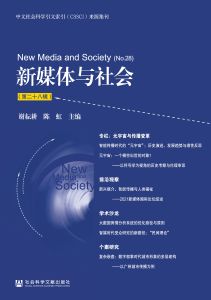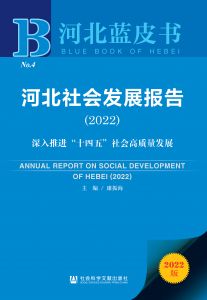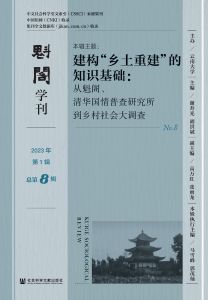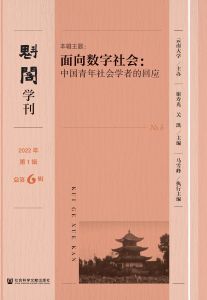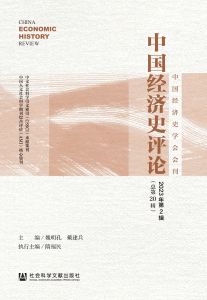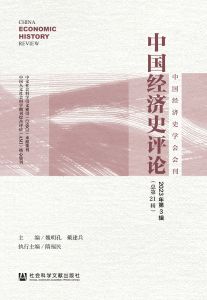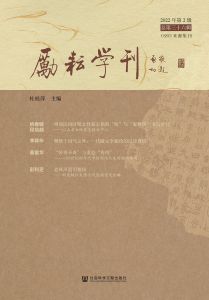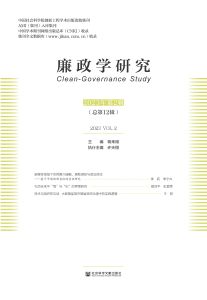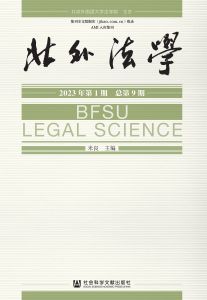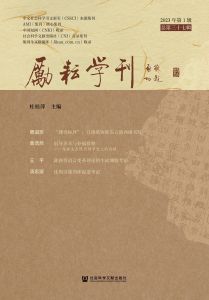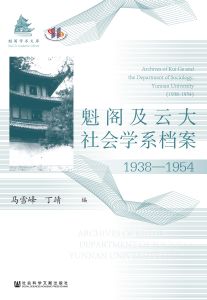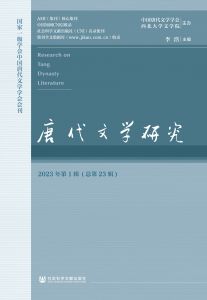首页 >
图书详情

图书简介
目录
参考文献
音频
视频
-
卷首语
-
AI与研究方法
-
大语言模型时代的社会学
-
《大语言模型时代的社会学》评审意见
-
婚姻的教育和民族匹配:基于ChatGPT的量化分析及文本生成
-
《婚姻的教育和民族匹配:基于ChatGPT的量化分析及文本生成》技术报告
-
《婚姻的教育和民族匹配:基于ChatGPT的量化分析及文本生成》评审意见
-
民族互嵌地区少数民族文化如何传承?
-
《民族互嵌地区少数民族文化如何传承?——基于ChatGPT的质性分析和文本生成》技术报告
-
《民族互嵌地区少数民族文化如何传承?——基于ChatGPT的质性分析和文本生成》评审意见
-
基于人工智能技术的翻译工具的翻译水平比较研究
-
ChatGPT 4.0生成学术论文全文的使用方法和评测
-
附录 重塑象牙塔
-
地方性知识在民族工艺传承上的嵌入
-
《地方性知识在民族工艺传承上的嵌入——基于鹤庆县银器传承的ChatGPT文本生成案例分析》技术报告
-
《地方性知识在民族工艺传承上的嵌入——基于鹤庆县银器传承的ChatGPT文本生成案例分析》评审意见
-
跨越边界的社会工作:社会工作参与边境服务的选择性嵌入策略
-
《跨越边界的社会工作:社会工作参与边境服务的“选择性嵌入”策略》技术报告
-
《跨越边界的社会工作:社会工作参与边境服务的“选择性嵌入”策略》评审意见
-
-
AI与社科研究
-
与ChatGPT“共舞”:人机协作的知识生产探索与反思
-
《与ChatGPT“共舞”:人机协作的知识生产探索与反思——以一项劳动控制的民族志研究为例》评审意见
-
社区老年高血压患者疾病感知的叙事分析
-
《社区老年高血压患者疾病感知的叙事分析》技术报告
-
《社区老年高血压患者疾病感知的叙事分析》评审意见
-
孝道观念变迁下的代际关系适应研究
-
《孝道观念变迁下的代际关系适应研究——基于ChatGPT整体取向的质性文本分析》技术报告
-
《孝道观念变迁下的代际关系适应研究——基于ChatGPT整体取向的质性文本分析》评审意见
-
社会支持研究中生成式人工智能的应用
-
附录A ChatGPT生成论文 社交媒体平台抑郁群体的社会支持研究
-
附录B Microsoft Bing生成论文 社交媒体平台抑郁群体的社会支持研究
-
附录C “文心一言”生成论文 社交媒体平台抑郁群体的社会支持研究
-
《社会支持研究中生成式人工智能的应用》评审意见
-
-
其他
-
AI辅助翻译:《人工智能与社会科学研究的变革——细致的偏差管理和数据保真是关键》
-
首届“魁阁”青年学者论坛
-
首届“魁阁”社会学人类学写作工作坊
-
研究乡村治理问题的一部力作
-
百年和顺图书馆提供了文化社会学研究的极好案例
-
[1][1]阿伯特,安德鲁,2019,《专业知识的未来》,《清华社会学评论》第2期。
[2][2]边燕杰,2015,《理论导向的实证社会学研究》,《中国社会科学评价》第2期。
[3][3]范晓光,2020,《数字化与实证社会学研究方法困境化解》,《中国社会科学评价》第3期。
[4][4]范晓光,2021,《计算社会学范式革命开拓新空间》,《中国社会科学报》8月20日。
[5][5]范晓光,2022,《计算社会科学须超越“精致的平庸”》,《中国社会科学报》11月16日。
[6][6]范晓光、刘金龙,2022,《计算社会学的基础问题及未来挑战》,《西安交通大学学报》第1期。
[7][7]范晓光、吕鹏,2023,《绪论》,载吕鹏、范晓光主编《计算社会科学导论》,清华大学出版社。
[8][8]洪永淼、汪寿阳,2023,《人工智能新近发展及其对经济学研究范式的影响》,《中国科学院院刊》第3期。
[9][9]吕鹏、龚顺、梅笑、刘金龙,2022a,《智能社会的崛起与人工智能的社会影响》,《智能社会研究》第1期。
[10][10]吕鹏、周旅军、范晓光,2022b,《平台治理场域与社会学参与》,《社会学研究》第3期。
[11][11]刘子曦,2018,《故事与讲故事:叙事社会学何以可能——兼谈如何讲述中国故事》,《社会学研究》第2期。
[12][12]邱泽奇,2022,《数字社会与计算社会学的演进》,《江苏社会科学》第1期。
[13][13]邱泽奇,2023,《“ChatGPT,你怎么看?”——与ChatGPT谈谈AIGC对人类职业的影响》,《探索与争鸣》第3期。
[14][14]王飞跃、缪青海,2023,《人工智能驱动的科学研究新范式:从AI4S到智能科学》,《中国科学院院刊》第4期。
[15][15]吴文峻、马宇晴、高雅君、刘祥龙,2023,《人工智能驱动科学研究新范式综述——模型、应用与案例》,《人工智能》第3期。
[16][16]叶启政,2018,《实证的迷失:重估社会科学经验研究》,社会科学文献出版社。
[17][17]赵鼎新,2015,《社会科学的研究困境:从与自然科学的区别谈起》,《社会学评论》第4期。
[18][18]赵一璋、王明玉,2023,《数字社会学:国际视野下的源起、发展与展望》,《社会学研究》第2期。
[19][19]政光景、吕鹏,2023,《生成式人工智能与哲学社会科学新范式的涌现》,《江海学刊》第4期。
[20][20]周旅军、吕鹏,2022,《“向善”且“为善”:人工智能时代的算法治理与社会科学的源头参与》,《求索》第3期。
[21][21]Abbott,A. 1992. “From Causes to Events:Notes on Narrative Positivism.” Sociological Methods & Research 20(4),428-455.
[22][22]Argyle,Lisa P.,et al. 2023. “Out of One,Many:Using Language Models to Simulate Human Samples.” Political Analysis 31(3):337-351.doi:10.1017/pan.2023.2.
[23][23]Birhane,A.,et al. 2023. “Science in the Age of Large Language Models.” Nature Reviews Physics 5,277-280.
[24][24]Buyalskaya,Anastasia,Gallo,Marcos and Camerer,Colin F. 2021. “The Golden Age of Social Science.” PNAS 118(5).
[25][25]Caren,Neal,Kenneth T.Andrews,and Rashawn Ray. 2023. “Extracting Protest Events from Newspaper Articles with ChatGPT.” SocArXiv .
[26][26]Elliott,J. 2005. Using Narrative in Social Research . London:SAGE Publications Ltd.
[27][27]Grigoropoulou,Nikolitsa and Small,Mario L. 2022. “The Data Revolution in Social Science Needs Qualitative Research.” Nature Human Behaviour ,https://doi.org/10.1038/s41562-022-01333-7.
[28][28]Grossmann,Igor,et al. 2023. “AI and the Transformation of Social Science Research.” Science 380,1108-1109.DOI:10.1126/science.adi1778.
[29][29]Hofman,et al. 2021. “Integrating Explanation and Prediction in Computational Social Science.” Nature 595,181-188.
[30][30]Kim,Junsol,and Lee,Byungkyu. 2023. “AI-Augmented Surveys:Leveraging Large Language Models for Opinion Prediction in Nationally Representative Survey.” ArXiv .
[31][31]Lorenz,Jan. 2021. “Data-Driven Agent-Based Modeling in Computational Social Science.” In Engel,U.,Quan-Haase,A.,Liu,S.,and E.Lyberg,L.(eds.). Handbook of Computational Social Science,Volume 1:Theory,Case Studies and Ethics (1st ed .). Routledge,pp.150-167.
[32][32]Lyberg,Lars and Heeringa,Steven G. 2021. “A Changing Survey Landscape.” In Engel,U.,Quan-Haase,A.,Liu,S.,and E.Lyberg,L.(eds.). Handbook of Computational Social Science,Volume 1:Theory,Case Studies and Ethics (1st ed .). Routledge,pp.83-99.
[33][33]Maines,David R. 1993. “Narrative’s Moment and Sociology’s Phenomena:Toward a Narrative Sociology.” The Sociological Quarterly ,34(1),17-38.
[34][34]Manzo,Gianluca. 2022. Agent-based Models and Causal Inference . NJ:John Wiley & Sons.
[35][35]OpenAI. 2023. “GPT-4 Technical Report.” Arxiv .
[36][36]Park,Joon Sung,et al. 2023. “Generative Agents:Interactive Simulacra of Human Behavior.” Arxiv .
[37][37]Rahwan,I.,Cebrian,M.,Obradovich,N.,et al. 2019. “Machine Behaviour.” Nature 568,477-486.
[38][38]Schwemmer,C.,and Wieczorek,O. 2020. “The Methodological Divide of Sociology:Evidence from Two Decades of Journal Publications.” Sociology 54(1),3-21.
[39][39]Wang,H.,et al. 2023. “Scientific Discovery in the Age of Artificial Intelligence.” Nature 620,47-60.
[40][40]Xiao,Ziang,et al. 2023. “Supporting Qualitative Analysis with Large Language Models:Combining Codebook with GPT-3 for Deductive Coding.” Arxiv .
[41][41]Zhu,Y.,Zhang,P.,Haq,E.,Hui,P.,and Tyson,G. 2023. “Can ChatGPT Reproduce Human-Generated Labels?A Study of Social Computing Tasks.” ArXiv,abs/2304.10145.
[42][42]杜永潇、董浩,2023,《城乡融合视角下中国婚姻匹配模式的差异与长期趋势:1960~2018》,《人口研究》第4期。
[43][43]高颖、张秀兰,2014,《北京近年族际通婚状况的实证研究》,《人口学刊》第1期。
[44][44]李晓霞,2004,《中国各民族间族际婚姻的现状分析》,《人口研究》第3期。
[45][45]李煜,2008,《婚姻的教育匹配:50年来的变迁》,《中国人口科学》第3期。
[46][46]李煜,2011,《婚姻匹配的变迁:社会开放性的视角》,《社会学研究》第4期。
[47][47]李煜、徐安琪,2004,《择偶模式和性别偏好研究——西方理论和本土经验资料的解释》,《青年研究》第10期。
[48][48]梁茂春,2004,《什么因素影响族际通婚?——社会学研究视角述评》,《西北民族研究》第3期。
[49][49]马戎,2001,《中国各民族之间的族际通婚》,载马戎著《民族与社会发展》,民族出版社。
[50][50]沈思、简小琴、徐世英,2019,《我国少数民族流动人口的族际通婚现状》,《人口研究》第6期。
[51][51]王德强、史冰清,2012,《民族区域自治制度与民族关系和谐的实证研究——基于云南藏区的问卷调查》,《民族研究》第2期。
[52][52]巫锡炜、刀玮皓,2022,《中国各民族族际通婚的结构特征:基于社会网络分析的考察》,《人口研究》第2期。
[53][53]徐安琪,2000,《择偶标准:五十年变迁及其原因分析》,《社会学研究》第6期。
[54][54]徐安琪、叶文振,1998,《婚姻质量:度量指标及其影响因素》,《中国社会科学》第1期。
[55][55]晏月平、李昀东、张舒贤、徐岗程,2022,《民族交融视角下云南省流动人口族际通婚变迁(2011—2018)》,《贵州民族研究》第3期。
[56][56]於嘉、谢宇,2013,《社会变迁与初婚影响因素的变化》,《社会学研究》第4期。
[57][57]张翼,2003,《中国阶层内婚制的延续》,《中国人口科学》第4期。
[58][58]Blossfeld,H.P.,& Timm,A. (Eds.)2003. Who Marries Whom ?Educational Systems as Marriage Markets in Modern Societies (Vol.12). Springer Science & Business Media.
[59][59]Breen,R. & L.Salazar. 2010. “Has Increased Women’s Educational Attainment Led to Greater Earnings Inequality in the United Kingdom?A Multivariate Decomposition Analysis.” European Sociological Review 26(2).
[60][60]Croll,E. 1984. “The Exchange of Women and Property:Marriage in Post-Revolutionary China.” In Women and Property (pp.44-61). Routledge.
[61][61]DiMaggio,P. & J.Mohr. 1985. “Cultural Capital,Educational Attainment,and Marital Selection.” American Journal of Sociology 90(6).
[62][62]Dong,H.,& Xie,Y. 2023. “Trends in Educational Assortative Marriage in China over the Past Century.” Demography 60(1),123-145.
[63][63]Esteve,A. & R.McCaa. 2008. “Assortative Mating Patterns in the Developing World.” In IUSSP Seminar on Changing Transitions to Marriage ,1-26.
[64][64]Han,H. 2010. “Trends in Educational Assortative Marriage in China from 1970 to 2000.” Demographic Research 22.
[65][65]Kalmijn,M. & H.Flap. 2001. “Assortative Meeting and Mating:Unintended Consequences of Organized Settings for Partner Choices.” Social Forces 79(4).
[66][66]Kalmijn,M. 1991a. “Shifting Boundaries:Trends in Religious and Educational Homogamy.” American Sociological Review 56(6).
[67][67]Kalmijn,M. 1991b. “Status Homogamy in the United States.” American Journal of Sociology 97(2).
[68][68]Kalmijn,M. 1994. “Assortative Mating by Cultural and Economic Occupational Status.” American Journal of Sociology 100(2),422-452.
[69][69]Mare,R.D. 1991. “Five Decades of Educational Assortative Mating.” American Sociological Review 56(1).
[70][70]Park,H.,& Smits,J. 2005. “Educational Assortative Mating in South Korea:Trends 1930-1998.” Research in Social Stratification and Mobility 23,103-127.
[71][71]Pisati,M. 2000. “sg142:Uniform Layer Effect Models for the Analysis of Differences in Two-Way Associations.” Stata Technical Bulletin 55:33-47.
[72][72]Qian,Z. 1997. “Breaking the Racial Barriers:Variations in Interracial Marriage between 1980 and 1990.” Demography 34(2),263-276.
[73][73]Qian,Z. 1998. “Changes in Assortative Mating:The Impact of Age and Education,1970-1890.” Demography 35(3).
[74][74]Raymo,J.M. & Y.Xie. 2000. “Temporal and Regional Variation in the Strength of Educational Homogamy.” American Sociological Review 65(5).
[75][75]Rosenfeld,M.J. 2008. “Racial,Educational and Religious Endogamy in the United States:A Comparative Historical Perspective.” Social Forces 87(1).
[76][76]Schwartz,C.R. & R.D.Mare. 2005. “Trends in Educational Assortative Marriage from 1940 to 2003.” Demography 42(4).
[77][77]Smits,J.,Ultee,W.,& Lammers,J. 1998. “Educational Homogamy in 65 Countries:An Explanation of Differences in Openness Using Country-Level Explanatory Variables.” American Sociological Review ,264-285.
[78][78]Smits,J.,W.Ultee & J.Lammers. 1998. “Educational Homogamy in 65 Countries:An Explanation of Differences in Openness Using Country-Level Explanatory Variables.” American Sociological Review 63(2).
[79][79]Smits,J. 2003. “Social Closure among the Higher Educated:Trends in Educational Homogamy in 55 Countries.” Social Science Research 32(2).
[80][80]Song,L. 2009. “The Effect of the Cultural Revolution on Educational Homogamy in Urban China.” Social Forces 88(1),257-270.
[81][81]Ultee,W.C.,& Luijkx,R. 1990. “Educational Heterogamy and Father-to-Son Occupational Mobility in 23 Industrial Nations:General Societal Openness or Compensatory Strategies of Reproduction?” European Sociological Review 6(2),125-149.
[82][82]Whyte,M.K.,& Parish,W.L. 1984. Urban Life in Contemporary China . Chicago:The University of Chicago Press.
[83][83]Xie,Y.,& Dong,H. 2021. “A New Methodological Framework for Studying Status Exchange in Marriage.” American Journal of Sociology 126(5),1179-1219.
[84][84]Xie,Y.,Cheng,S.,& Zhou,X. 2015. “Assortative Mating without Assortative Preference.” Proceedings of the National Academy of Sciences 112(19),5974-5978.
[85][85]Xie,Y. 1992. “The Log-Multiplicative Layer Effect Model for Comparing Mobility Tables.” American Sociological Review ,380-395.
[86][86]Xu,X.,J.Ji & Y.Y.Tung. 2000. “Social and Political Assortative Mating in Urban China.” Journal of Family Issues 21(1).
[87][87]Yu,J. & Y.Xie. 2015. “Changes in the Determinants of Marriage Entry in Post-Reform Urban China.” Demography 52(6).
[88][88]毕曼,2021,《少数民族传统文化现代转化的规律与策略研究——以恩施土家“女儿会”为例》,《华中师范大学学报》(人文社会科学版)第6期。
[89][89]范小青,2022,《从传统社区到网络社群:少数民族非遗传承场域变迁》,《中央民族大学学报》(哲学社会科学版)第2期。
[90][90]冯雪红、张欣,2021,《民族互嵌研究现状与未来走向》,《西南民族大学学报》(人文社会科学版)第5期。
[91][91]黄永林,2013,《“文化生态”视野下的非物质文化遗产保护》,《文化遗产》第5期。
[92][92]黎平辉,2014,《资源开发与文化传承——西部民族地区农村学前教育内生型发展模式探究》,《民族教育研究》第1期。
[93][93]刘成,2015,《民族互嵌理论新思考》,《广西民族研究》第6期。
[94][94]沙彦奋、陈燕,2023,《民族互嵌论》,《中南民族大学学报》(人文社会科学版)4月14日。
[95][95]滕星,1998,《民族教育概念新析》,《民族研究》第2期。
[96][96]王建民,2012,《扶贫开发与少数民族文化——以少数民族主体性讨论为核心》,《民族研究》第3期。
[97][97]吴胜艳、李超、谢广营,2022,《田园综合体:少数民族传统村落保护与发展路径研究——基于贵州黔东南州苗族郎德村的扎根分析》,《原生态民族文化学刊》第6期。
[98][98]邢瑞娟、王文东,2021,《乡村振兴战略下贵州少数民族民间工艺传承与发展的对策》,《贵州民族研究》第3期。
[99][99]晏鲤波,2007,《少数民族文化传承综论》,《思想战线》第3期。
[100][100]杨福泉,2007,《少数民族文化保护与传承新论》,《云南社会科学》第6期。
[101][101]杨振之,2006,《前台、帷幕、后台——民族文化保护与旅游开发的新模式探索》,《民族研究》第2期。
[102][102]张会龙,2015,《论我国民族互嵌格局的历史流变与当代建构》,《思想战线》第6期。
[103][103]赵世林,2002,《论民族文化传承的本质》,《北京大学学报》(哲学社会科学版)第3期。
[104][104]Hansen,M.H. 1999. “Education and Chinese Minority Policy.” In Lessons in Being Chinese:Minority Education and Ethnic Identity in Southwest China . University of Washington Press.
[105][105]Harrell,S. 1995. “The History of the History of the Yi.” In S.Harrell(ed.). Cultural Encounters on China’s Ethnic Frontiers . University of Washington Press.
[106][106]Lai,A.H.Y.,Chui,C.H.K.,Hausmann-Stabile,C.,Yao,H.,Wong,J.K.Y.,& Di,S. 2023. “Ethnic Identity in School Context:The Case of Yi Ethnic Minority Adolescents in Rural China.” Children & Society ,1-21.
[107][107]Li,Xiyuan. 2015. “Ethnicity or Nationality?:Minority Policy and Ethnic Conflict in Contemporary China.” In University of Cologne Forum Ethnicity as a Political Resource(ed .). Ethnicity as a Political Resource:Conceptualizations across Disciplines,Regions,and Periods . Transcript Verlag.
[108][108]Li,Yang. 2013. “Ethnic Tourism and Minority Identity:Lugu Lake,Yunnan,China.” Asia Pacific Journal of Tourism Research ,18(7),712-730.
[109][109]Yan,Fei. 2020. “Education for Inclusion or Exclusion:Representation of Ethnic Minorities in Chinese Mainstream History Textbooks.” In A.Brown & E.Wisby(eds.). Knowledge,Policy and Practice in Education and the Struggle for Social Justice:Essays Inspired by the Work of Geoff Whitty . UCL Press.
[110][110]Yang,Fuquan. 2016. “Ethnic Heritage in Yunnan:Contradictions and Challenges.” In A.Matsuda & L.E.Mengoni(eds.). Reconsidering Cultural Heritage in East Asia . Ubiquity Press.
[111][111]Newman,L.(2020). “The Rise of Artificial Intelligence:Implications for Various Industries”. Journal of Technological Studies.
[112][112]Jones,R.(2019). “AI in Academia:The Democratization of Knowledge”. AI and Society Journal.
[113][113]Rajpurkar,P.,Irvin,J.,Ball,R.L.,Zhu,K.,Yang,B.,Mehta,H.,…& Ng,A.Y.(2017). “Deep learning for chest radiograph diagnosis:A retrospective comparison of the CheXNeXt algorithm to practicing radiologists”. PLoS medicine,15(11),e1002686.Link
[114][114]Knight,W.(2017). “AI tools will make it easy to create fake porn of just about anybody”. MIT Technology Review. Link
[115][115]Brown,T.,et al. 2020. “Language Models Are Few-Shot Learners.” Advances in Neural Information Processing Systems 33.
[116][116]Bostrom,N. 2014. Superintelligence:Paths,Dangers,Strategies . Oxford University Press.
[117][117]Benkler,Y. 2016. “Degrees of Freedom,Dimensions of Power.” Daedalus 145(1).
[118][118]Broussard,M. 2019. Artificial Unintelligence:How Computers Misunderstand the World . MIT Press.
[119][119]Callaway,E. 2020. “Will Computers ever Rival the Complexity of Human Thought?” Nature 587(7835).
[120][120]De Fauw,J.,et al. 2018. “Clinically Applicable Deep Learning for Diagnosis and Referral in Retinal Disease.” Nature Medicine 24(9).
[121][121]Durkheim,E. 2013. The Division of Labor in Society . Simon and Schuster.
[122][122]Eisenstein,J.,et al. 2014. “Diffusion of Lexical Change in Social Media.” PloS One 9(11).
[123][123]Engels,F.,and Karl Marx. 2004. The Communist Manifesto . Penguin UK.
[124][124]Eisenstein,E.L. 1980. The Printing Press as an Agent of Change . Cambridge University Press.
[125][125]Floridi,L.,and J.Cowls. 2021. “A Unified Framework of Five Principles for AI in Society.” Ethics,Governance,and Policies in Artificial Intelligence 144.
[126][126]Foucault,M. 1979. “Truth and Power:An interview with Michel Foucault.” Critique of Anthropology 4(13-14).
[127][127]Gershman,S.J.,and D.M.Blei. 2012. “A Tutorial on Bayesian Nonparametric Models.” Journal of Mathematical Psychology 56(1).
[128][128]Harari,Y.N. 2018. 21 Lessons for the 21st Century . National Geographic Books.
[129][129]Knight,W. 2017. “The Dark Secret at the Heart of AI.” MIT Technology Review 120(3).
[130][130]LeCun,Y.,Y.Bengio,and G.Hinton. 2015. “Deep learning.” Nature 521(7553).
[131][131]Latour,B. 2005. Reassembling the Social:An Introduction to Actor-Network-Theory . Oxford University Press.
[132][132]Nahian,M.S.A.,et al. 2020. “Learning Norms from Stories:A Prior for Value Aligned Agents.” Proceedings of the AAAI /ACM Conference on AI,Ethics,and Society .
[133][133]O’ Neil,C. 2016. Weapons of Math Destruction:How Big Data Increases Inequality and Threatens Democracy . Crown.
[134][134]Rajpurkar,P.,et al. 2018. “Deep Learning for Chest Radiograph Diagnosis:A Retrospective Comparison of the CheXNeXt Algorithm to Practicing Radiologists.” PLoS Medicine 15(11).
[135][135]Rainie,L. & Anderson,J. 2017. Code-Dependent:Pros and Cons of the Algorithm Age . Pew Research Center:Internet,Science & Tech.
[136][136]Schmidhuber,J. 2015. “Deep Learning in Neural Networks:An Overview.” Neural Networks 61.
[137][137]Sirignano,J.,and R.Cont. 2019. “Universal Features of Price Formation in Financial Markets:Perspectives from Deep Learning.” Quantitative Finance 19(9).
[138][138]Simmel,G. 2014. “The Metropolis and Mental Life.” In The People,Place,and Space Reader . Routledge,223-226.
[139][139]Sartre,J.-P. 1993. Being and Nothingness . Washington Square Press.
[140][140]Said,E.W. 1977. “Orientalism.” Georgia Review 31,162-206.
[141][141]Sutton,C.,and L.Gong. 2017. “Popularity of arXiv.org within Computer Science.” arXiv preprint ,arXiv:1710.05225.
[142][142]Veblen,T. 2016. The Theory of the Leisure Class . CreateSpace Independent Publishing Platform.
[143][143]Vinuesa,R.,et al. 2020. “The Role of Artificial Intelligence in Achieving the Sustainable Development Goals.” Nature Communications 11(1).
[144][144]Writer,B. 2019. “Lithium-Ion Batteries.” In A Machine-Generated Summary of Current Research . Cham:Springer International Publishing 3.
[145][145]Weber,M. 2014. The Protestant Ethic and the Spirit of Capitalism . Angelico Press.
[146][146]巴战龙,2009,《地方知识的本质与构造——基于乡村社区民族志研究的阐释》,《西北民族研究》第1期。
[147][147]波兰尼,卡尔,2007,《大转型:我们时代的政治与经济起源》,冯钢、刘阳译,浙江人民出版社。
[148][148]陈恩维,2020,《地方性知识与非遗的整体性保护——基于广东勒流“扒龙舟”的考察》,《民族艺术》第3期。
[149][149]段义孚,2017,《地方:记忆想象与认同》,台北:群学出版有限公司。
[150][150]樊泳湄、谭藯沁,2011,《云南少数民族传统文化变迁研究——以大理白族自治州鹤庆县新华村白族手工艺品为例》,《学术探索》第2期。
[151][151]范建华、张睿莲,2013,《中国城镇化之路新探索:来自云南大理新华村的启示》,《学术探索》第4期。
[152][152]方李莉,2021,《手工艺与当代中国生活方式的重塑》,《民俗研究》第3期。
[153][153]胡洪斌、赵悦彤,2023,《文化产业研究从“特色”转向“区域”的理论思考》,《中国文化产业评论》第2期。
[154][154]胡惠林,2000,《文化产业发展与国家文化安全——全球化背景下中国文化产业发展问题思考》,《上海社会科学院学术季刊》第2期。
[155][155]胡惠林,2013,《时间与空间文化经济学论纲》,《探索与争鸣》第5期。
[156][156]吉尔兹,克利福德,2000,《地方性知识:阐释人类学论文集》,王海龙、张家瑄译,中央编译出版社。
[157][157]江帆,2012,《地方性知识中的生态伦理与生存智慧》,《山东社会科学》第11期。
[158][158]李炎,2011,《再显与重构》,云南大学出版社。
[159][159]李炎、王佳,2008,《传统民族工艺:西部民族地区文化产业发展的一种模式——滇西北民族工艺品产业化开发调查》,《中国文化产业评论》第2期。
[160][160]梁永华、李启强,2013,《论白族银器文化艺术特点——以大理鹤庆新华村白族银器为例》,《青年文学家》第7期。
[161][161]盛晓明,2000,《地方性知识的构造》,《哲学研究》第12期。
[162][162]孙杰远、乔晓华,2021,《地方性知识的内涵、特征及其教育意蕴——读吉尔兹〈地方性知识——阐释人类学论文集〉》,《教育理论与实践》第13期。
[163][163]孙九霞、刘相军,2014,《地方性知识视角下的传统文化传承与自然环境保护研究——以雨崩藏族旅游村寨为例》,《中南民族大学学报》(人文社会科学版)第6期。
[164][164]王文章,2006,《非物质文化遗产概论》,文化艺术出版社。
[165][165]吴彤,2007,《两种地方性知识》,《自然辩证法研究》第11期。
[166][166]杨娟、段香丽、陈冬前,2017,《关于云南大理白族传统社会文化变迁的调查研究——以大理剑川、鹤庆地区为例》,《现代交际》第12期。
[167][167]杨庭硕,2005,《地方性知识的扭曲、缺失和复原——以中国西南地区的三个少数民族为例》,《吉首大学学报》(社会科学版)第2期。
[168][168]叶舒宪,2001,《地方性知识》,《读书》第5期。
[169][169]张瑾,2011,《民族旅游语境中的地方性知识与红瑶妇女生计变迁——以广西龙胜县黄洛瑶寨为例》,《旅游学刊》第8期。
[170][170]郑海、王菁、林巧等,2012,《云南民族传统手工艺品:美丽背后的困惑》,《今日民族》第7期。
[171][171]周俊华、秦继仙,2008,《全球化语境下民族地方性知识的价值与民族的现代发展——以纳西族为例》,《云南民族大学学报》(哲学社会科学版)第5期。
[172][172]周星,2021,《民俗语汇·地方性知识·本土人类学》,《社会学评论》第3期。
[173][173]朱洪启,2007,《地方性知识的变迁与保护——以浙江青田龙现村传统稻田养鱼体系的保护为例》,《广西民族大学学报》(哲学社会科学版)第4期。
[174][174]Choi,E.P.H.,Lee,J.J.,Ho M-H,et al. 2023. “Chatting or Cheating?The Impacts of ChatGPT and Other Artificial Intelligence Language Models on Nurse Education.” Nurse Education Today ,125.
[175][175]Hung,J.,and Chen,J. 2023. “The Benefits,Risks and Regulation of Using ChatGPT in Chinese Academia:A Content Analysis.” Social Sciences ,12(7).
[176][176]Islam,I.,and Islam,M.N. 2023. “Opportunities and Challenges of Chatgpt in Academia:A Conceptual Analysis.” Authorea Preprints,Feb 23.
[177][177]Korinek,A. 2023. “Language Models and Cognitive Automation for Economic Research.” National Bureau of Economic Research ,No.w30957.
[178][178]OpenAI. “GPT-4”.(2023-08-30)[2023-08-31]. https://openai.com/gpt-4.
[179][179]Taecharungroj,V. 2023. “‘What Can ChatGPT Do?’ Analyzing Early Reactions to the Innovative AI Chatbot on Twitter.” Big Data and Cognitive Computing ,7(1).
[180][180]Tdergaa,I.,Chamari,K.,Zmijewski,P.,et al. 2023. “From Human Writing to Artificial Intelligence Generated Text:Examining the Prospects and Potential Threats of ChatGPT in Academic Writing.” Biol Sport ,40(2).
[181][181]Tiunova,A.,and Muñoz,F. 2023. “Chatgpt:Using Ai in Social Studies Academic Rese-arch”. Available at SSRN:4451612.
[182][182]Yin,R.K. 2015. Qualitative Research from Start to Finish,Second Edition . Guilford Publications.
[183][183]波兰尼,卡尔,2007,《大转型——我们时代的政治与经济起源》,冯钢、刘阳译,浙江人民出版社。
[184][184]陈立周,2017,《“找回社会”:中国社会工作转型的关键议题》,《思想战线》第1期。
[185][185]古学斌、张和清、杨锡聪,2016,《专业限制与文化识盲:农村社会工作实践中的文化问题》,《社会学研究》第6期。
[186][186]郭伟和,2007,《体制内演进与体制外发育的冲突——中国农村社会工作的制度性条件反思》,《北京科技大学学报》(社会科学版)第 4 期。
[187][187]吉登斯,安东尼,2015,《社会理论的核心问题:社会分析中的行动、结构与矛盾》,郭忠华、徐法寅译,上海译文出版社。
[188][188]吉登斯,安东尼,2022,《现代性的后果》(修订版),田禾译,译林出版社。
[189][189]李小云、陈邦炼、宋海燕等,2019,《“妇女贫困”路径的减贫溢出与赋权异化——一个少数民族妇女扶贫实践的发展学观察》,《妇女研究论丛》第2期。
[190][190]王思斌,1995,《中国社会工作的经验与发展》,《中国社会科学》第2期。
[191][191]王思斌,2011,《中国社会工作的嵌入性发展》,《社会科学战线》第2期。
[192][192]向羽、张和清,2023,《政府购买服务准市场化的异化与中国特色社会工作发展道路反思——以广东社会工作发展历程为例》,《暨南学报》(哲学社会科学版)第2期
[193][193]熊跃根,2005,《转型时期中国社会工作专业教育发展的路径与策略:理论解释与经验反思》,《华东理工大学学报》(社会科学版)第1期。
[194][194]徐选国,2019,《从嵌入系统到嵌入生活:我国社会工作的范式转向与时代选择》,《社会工作与管理》第3期。
[195][195]徐选国、罗茜,2020,《嵌入何以发展:社会工作本土化进程中嵌入观的流变与再构》,《新视野》第1期。
[196][196]Adler,P.S. & Kwon,S.W. 2002. “Social Capital:Prospects for a New Concept.” The Academy of Management Review 27(1).
[197][197]Androff,D.K. & Tavassoli,K.Y. 2012. “Deaths in the Desert:The Human Rights Crisis on the U.S.-Mexico Border.” Social Work 57(2).
[198][198]Baum,A.C.,& Oliver,C. 1991. “Institutional Linkages and Organizational Mortality.” Administrative Science Quarterly 36(2).
[199][199]Baum,A.C.,& Oliver,C. 1992. “Institutional Embeddedness and the Dynamics of Organizational Populations.” American Sociological Review 57(4).
[200][200]Dacin,M.T. 1999. “The Embeddedness of Organizations:Dialogue & Directions.” Journal of Management ,25(3).
[201][201]Faver,Catherine,A.,Alonzo,M.Cavazos & Brian,L.Trachte. 2005. “Social Work Students at the Border:Religion,Culture,and Beliefs about Poverty.” Journal of Baccalaureate Social Work 11(1).
[202][202]Giddens,A. 1984. The Constitution of Society:Outline of the Theory of Structuration . California:University of California Press.
[203][203]Granovetter,M. 1973. “The Strength of Weak Ties.” American Journal of Sociology 78(6).
[204][204]Granovetter,M. 1985. “Economic Action and Social Structure:The Problem of Embeddedness.” American Journal of Sociology ,91(3).
[205][205]Gulati,R. 1998. “Alliances and Networks.” Strategic Management Journal 19(4).
[206][206]Holtzhausen,L. & Oliphant,E. 2008. “Migrant Workers in South Africa and the United Arab Emirates.” The International Journal of Diversity in Organizations,Communities,and Nations:Annual Review 8(5).
[207][207]Jeyapal,D. 2017. “The Evolving Politics of Race and Social Work Activism:A Call across Borders” Social Work 62(1).
[208][208]Johnson,C.,Jones,R.,Paasi,A.,Amoore,L.,Mountz,A.,Salter,M. & Rumford,C. 2011. “Interventions on Rethinking ‘the Border’ in Border Studies.” Political Geography 30(2).
[209][209]Melendres,M. 2020. “Cultural Competence in Social Work Practice:Exploring the Challenges of Newly Employed Social Work Professionals.” Journal of Ethnic & Cultural Diversity in Social Work 31(2).
[210][210]Negi,N.J. & Furman,R. (eds.)2010. Transnational Social Work Practice . New York:Columbia University Press.
[211][211]Newman,D. 2006. “Borders and Bordering:Towards an Interdisciplinary Dialogue.” European Journal of Social Theory 9(2).
[212][212]Oliver,C. 1990. “Determinants of Interorganizational Relationships:Integration and Future Directions.” The Academy of Management Review 15(2).
[213][213]Parada,H. 2007. “Social Work in Latin America:History,Challenges and Renewal.” International Social Work 50(4).
[214][214]Schrooten,M.,Thys,R. & Debruyne,P. (eds.)2019. Sociaal Schaduwwerk Over Informele Spelers in Het Welzijnslandschap . Politeia.
[215][215]Schrooten,M. 2021. “Transnational Social Work:Challenging and Crossing Borders and Bo-undaries.” Journal of Social Work 21(5).
[216][216]Turid,M. 2019. “Social Work and Welfare Bordering:the Case of Homeless EU Migrants in Norway.” European Journal of Social Work 23(5).
[217][217]Uzzi,B. 1996. “The Sources and Consequences of Embeddedness for the Economic Performance of Organizations:The Network Effect.” American Sociological Review 61(4).
[218][218]布若威,迈克尔,2008,《制造同意——垄断资本主义劳动过程的变迁》,李荣荣译,商务印书馆。
[219][219]陈心想,2019,《社会学美国化的历程及其对构建中国特色社会学的启示》,《社会学研究》第1期。
[220][220]戴岭、胡姣、祝智庭,2023,《ChatGPT赋能教育数字化转型的新方略》,《开放教育研究》第4期。
[221][221]高丙中,2006,《一座博物馆—庙宇建筑的民族志——论成为政治艺术的双名制》,《社会学研究》第1期。
[222][222]高艺多,2022,《复杂的内心世界:社会工作者的情感劳动过程研究》,《社会工作与管理》第1期。
[223][223]葛忠明,2015,《从专业化到专业主义:中国社会工作专业发展中的一个潜在问题》,《社会科学》第4期。
[224][224]郝祥军、贺雪,2022,《AI与人类智能在知识生产中的博弈与融合及其对教育的启示》,《华东师范大学学报》(教育科学版)第9期。
[225][225]何哲、曾润喜、秦维等,2023,《ChatGPT等新一代人工智能技术的社会影响及其治理》,《电子政务》第4期。
[226][226]胡高强,2021,《社会工作者工作支持、职业认同与工作情绪》,《调研世界》第4期。
[227][227]胡荣、石柏林,2022,《工作支持对社会工作者离职意愿的影响研究——基于“中国社会工作动态调查”(CSWLS2019)的实证分析》,《华东理工大学学报》(社会科学版)第3期。
[228][228]胡泳,2023,《超越ChatGPT:大型语言模型的力量与人类交流的困境》,《新闻记者》第8期。
[229][229]金源、魏振、李成智,2023,《基于ChatGPT的问答式财务知识库构建与应用》,《财会月刊》第17期。
[230][230]李培智,2012,《大学生实习劳动关系认定探微》,《法学杂志》第6期。
[231][231]刘日明、刘小涛,2022,《智能知识生产模式的本质特征和社会驱动》,《社会科学》第8期。
[232][232]刘玮,2023,《ChatGPT类生成式人工智能嵌入数字政府建设:可供、限制与优化——基于技术可供性视角》,《情报理论与实践》8月25日。
[233][233]刘艳霞、张瑞凯,2019,《社会工作实习教育成效的组织因素分析——基于6所高校的抽样调查》,《浙江学刊》第3期。
[234][234]骆飞、马雨璇,2023,《人工智能生成内容对学术生态的影响与应对——基于ChatGPT的讨论与分析》,《现代教育技术》第6期。
[235][235]马良,2011,《构建“实习、教学、研究”三位一体的社会工作实习基地研究》,《浙江工商大学学报》第4期。
[236][236]默顿,R.K.,2003,《科学社会学》,鲁旭东、林聚任译,商务印书馆。
[237][237]牛静、赵一菲,2020,《“倒贴钱”的实习如何可能?——新闻媒体实习生劳动过程中的同意制造与“理想游戏”》,《新闻与传播研究》第4期。
[238][238]唐立、费梅苹,2020,《薪酬激励抑或情感支持:社会工作者流失之因探究》,《青年研究》第2期。
[239][239]王俊美,2023,《ChatGPT改变人类知识生产方式》,《中国社会科学报》2月20日。
[240][240]王琪,2023,《技术赋能与问题衍生:ChatGPT对学术期刊出版的影响》,《河南大学学报》(社会科学版)第5期。
[241][241]王智慧,2023,《对话ChatGPT:体育社会学的优势何在?》,《武汉体育学院学报》第5期。
[242][242]徐道稳,2019,《我国社会工作者工资决定机制研究——基于对深圳市社会工作实践的分析》,《中央民族大学学报》(哲学社会科学版)第3期。
[243][243]杨发祥、李安琪,2021,《社会工作介入突发性公共卫生事件研究——基于情感劳动的视角》,《学海》第3期。
[244][244]杨发祥、叶淑静,2016,《结构性约束与主体性建构:社会工作者的职业认同》,《江海学刊》第6期。
[245][245]游正林,2009,《制造认同的又一种模式G公司协调劳资关系的基本经验》,《社会》第1期。
[246][246]袁小良、徐雯,2016,《社会服务机构中社会工作者激励因素研究》,《社会建设》第4期。
[247][247]曾守锤、李筱、何雪松、陈魏,2019,《中国社工的离职倾向及其影响因素研究》,《重庆工商大学学报》(社会科学版)第4期。
[248][248]张大维、郑永君、李静静,2014,《社会环境、社会支持与社会工作者的职业耗竭——基于广深莞汉100名专职社工的调查》,《中州学刊》第2期。
[249][249]张洪忠、黄民烈、张伟男等,2023,《ChatGPT的技术逻辑、社会影响与传播学未来》,《江西师范大学学报》(哲学社会科学版)第2期。
[250][250]张强、高颖、赵逸淳、张雪峰,2023,《ChatGPT在智慧图书馆建设中的机遇与挑战》,《图书馆理论与实践》8月15日。
[251][251]张钺、李正风、潜伟,2023,《从ChatGPT到人机协作的知识共建》,《科学学研究》8月17日。
[252][252]赵一红、庞志,2017,《社会工作专业人才队伍激励机制建设研究——基于北京市持证社工抽样调查的数据分析》,《社会建设》第3期。
[253][253]郑广怀、孙慧、万向东,2015,《从“赶工游戏”到“老板游戏”——非正式就业中的劳动控制》,《社会学研究》第3期。
[254][254]陈向明,2000,《质的研究方法与社会科学研究》,教育科学出版社。
[255][255]计海霞、张建凤、张蕾、汪凯、龚桂平、王霞,2016,《缺血性脑卒中患者疾病感知的影响因素分析》,《中国动脉硬化杂志》第10期。
[256][256]靳伟,2022,《老年高血压患者自我管理水平现状与影响因素分析》,《基层医学论坛》第1期。
[257][257]梁秀容、谢水莲,2018,《认知干预对老年原发性高血压病患者疾病认知与治疗依从性的影响》,《护理实践与研究》第9期。
[258][258]邵申申、张萍、万小惠,2018,《社区高血压病人自我管理干预模式的研究现状》,《护理研究》第23期。
[259][259]汪清秀、孙旭文、石鸿艳、韦晓红,2015,《知信行模式干预对社区老年高血压患者自我管理行为的影响》,《护理学杂志》第1期。
[260][260]王文良,2005,《社区高血压自我管理和行为干预效果评估》,《中国健康教育杂志》第4期。
[261][261]王益明、金瑜,2002,《自我管理研究述评》,《心理科学杂志》第4期。
[262][262]张丽丽、董建群,2010,《慢性病患者自我管理研究进展》,《中国慢性病预防与控制》第2期。
[263][263]张绮阁,2017,《老年高血压病患者自我管理水平现状调查研究与相关影响因素分析》,《护理实践与研究》第24期。
[264][264]Bokhour,B.G.,E.S.Cohn,D.E.Cortes,J.L.Solomon,G.M.Fix,A.R.Elwy,N.Mu-eller,L.A.Katz,P.Haidet,A.R.Green,A.M.Borzecki,& N.R.Kressin. 2012. “The Role of Patients’ Explanatory Models and Daily-Lived Experience in Hypertension Self-Management.” Journal of General Internal Medicine 12.
[265][265]Clarke,D.M.,& K.C.Curri. 2009. “Depression,Anxiety and Their Relationship with Chronic Diseases:A Review of the Epidemiology,Risk and Treatment Evidence.” Medical Journal of Australia 190.
[266][266]Gholamnejad,H.,A.Darvishpoor Kakhki,F.Ahmadi,& C.Rohani. 2018. “Barriers to Self-Care in Elderly People with Hypertension:A Qualitative Study.” Working with Older People 4.
[267][267]Hagger,M.S.,& S.Orbell. 2003. “A Meta-Analytic Review of the Common-Sense Model of Illness Representations.” Psychology and health 2.
[268][268]Lamar,M.,D.Wu,R.A.Durazo-Arvizu,A.M.Brickman,H.M.Gonzalez,W.Tarraf,& M.I.Daviglus. 2017. “Cognitive Associates of Current and More Intensive Control of Hypertension:Findings from the Hispanic Community Health Study/Study of Latinos.” American Journal of Hypertens 6.
[269][269]Leventhal,H.,M.A.Safer,& D.M.Panagis. 1983. “The Impact of Communications on the Self-Regulation of Health Beliefs,Decisions,and Behavior.” Health Education Quarterly 1.
[270][270]Li,Y.,L.Yang,L.Wang,M.Zhang,Z.Huang,Q.Deng,& L.Wang. 2017. “Burden of Hypertension in China:A Nationally Representative Survey of 174,621 Adults.” International Journal of Cardiology 227.
[271][271]Lu,Y.,P.Wang,T.Zhou,J.Lu,E.S.Spatz,K.Nasir,L.Jiang,& H.M.Krumholz. 2018. “Comparison of Prevalence,Awareness,Treatment,and Control of Cardiovascular Risk Factors in China and the United States.” Journal of American Heart Association 3.
[272][272]Ma,L.,L.Zhang,F.Sun,Y.Li,& Z.Tang. 2018. “Frailty in Chinese Older Adults with Hypertension:Prevalence,Associated Factors,and Prediction for Long-Term Mortality.” Journal of Clinical Hypertens (Greenwich )11.
[273][273]Mills,K.T.,A.Stefanescu,& J.He. 2020. “The Global Epidemiology of Hypertension.” National Review of Nephrol 4.
[274][274]Muela,H.C.,V.A.Costa-Hong,M.S.Yassuda,N.C.Moraes,C.M.Memoria,M.F.Ma-chado,T.A.Macedo,E.B.Shu,A.R.Massaro,R.Nitrini,A.J.Mansur,& L.A.Bo-rtolotto. 2017. “Hypertension Severity is Associated with Impaired Cognitive Performan-ce.” Journal of American Heart Association 1.
[275][275]Ryuno,H.,K.Kamide,Y.Gondo,M.Kabayama,R.Oguro,C.Nakama,S.Yokoyama,M.Nagasawa,S.Maeda-Hirao,Y.Imaizumi,M.Takeya,H.Yamamoto,M.Takeda,Y.Takami,N.Itoh,Y.Takeya,K.Yamamoto,K.Sugimoto,T.Nakagawa,…H.Rakugi. 2017. “Longitudinal Association of Hypertension and Diabetes Mellitus with Cognitive Functioning in a General 70-Year-Old Population:The SONIC Study.” Hypertens Research 7.
[276][276]van Bussel,E.,L.Reurich,J.Pols,E.Richard,E.Moll van Charante,& S.Ligthart. 2019. “Hypertension Management:Experiences,Wishes and Concerns among Older People-A qualitative Study.” BMJ Open 8.
[277][277]Yang,L.,B.Winslow,J.Huang,& N.Zhou. 2021. “Study on Illness Perceptions of Chinese Rural-Dwelling Adults with Hypertension:A Descriptive Study.” Public Health Nursing 1.
[278][278]Yoon,H.,S.Kim,M.Naseh,Y.C.Huang,& Y.Jang. 2022. “Chronic Conditions and Psychological Distress in Older Asian Americans:The Mediating Role of Subjective Health Perception.” Journal of Gerontological Social Work 6.
[279][279]Zhou,J.,& S.Fang. 2019. “Association between Undiagnosed Hypertension and Health Factors among Middle-Aged and Elderly Chinese Population.” International Journal of Environmental Research and Public Health 7.
[280][280]Lee,H. 2023. “The Rise of ChatGPT:Exploring Its Potential in Medical Education.” Anatomical Sciences Education 00,1-6.
[281][281]Rahman,M.M.,Terano,H.J.,Rahman,M.N.,Salamzadeh,A.,& Rahaman,M.S. 2023. “ChatGPT and Academic Research:A Review and Recommendations Based on Practical Examples.” Journal of Education,Management and Development Studies 3(1),1-12.
[282][282]Rahman,M.,Terano,H.J.R.,Rahman,N.,Salamzadeh,A.,Rahaman,S. 2023. “ChatGPT and Academic Research:A Review and Recommendations Based on Practical Examples.” Journal of Education,Management and Development Studies 3(1),1-12.
[283][283]陈柏峰,2009,《人际关系变动与老年人自杀——对湖北京山农村的实证研究》,《社会学研究》第4期。
[284][284]陈滔、卿石松,2019,《中国孝道观念的代际传递效应》,《人口与经济》第2期。
[285][285]陈咏媛、康萤仪,2015,《当代中国文化变迁与文化混搭的动态过程:社会生态学的视角》,《中国社会心理学评论》总第9辑。
[286][286]邓凌,2004,《大学生孝道观的调查研究》,《青年研究》第11期。
[287][287]邓希泉、风笑天,2003,《城市居民孝道态度与行为的代际比较》,《中国青年研究》第3期。
[288][288]葛枭语,2021,《孝的多维心理结构:取向之异与古今之变》,《心理学报》第3期。
[289][289]郭于华,2001,《代际关系中的公平逻辑及其变迁——对河北农村养老事件的分析》,《中国学术》第4期。
[290][290]何哲、曾润喜、秦维、郑磊、张宏、张效羽、马亮、翟云、潘云龙、李晓方、彭云、张楠,2023,《ChatGPT 等新一代人工智能技术的社会影响及其治理》,《电子政务》第4期。
[291][291]胡安宁,2017,《老龄化背景下子女对父母的多样化支持:观念与行为》,《中国社会科学》第3期。
[292][292]黄坚厚,1989,《现代生活孝的实践:中国人的心理》(1989年版),台北:桂冠图书公司。
[293][293]吉登斯,安东尼,2000,《现代性的后果》,田禾译,译林出版社。
[294][294]康岚,2012,《代差与代同:新家庭主义价值的兴起》,《青年研究》第3期。
[295][295]刘汶蓉,2012,《孝道衰落?成年子女支持父母的观念、行为及其影响因素》,《青年研究》第2期。
[296][296]刘汶蓉,2016,《转型期的家庭代际情感与团结——基于上海两类“啃老”家庭的比较》,《社会学研究》第4期。
[297][297]米德,玛格丽特,1988,《代沟》,曾胡译,光明日报出版社。
[298][298]苗国,2006,《从青年单身浪潮反思观念上的代际冲突——结合个案访谈对大城市未婚族的一项研究》,《中国青年研究》第12期。
[299][299]潘乃谷,2011,《费孝通在世纪初的期盼》,载李培林主编《费孝通与中国社会学》,社会科学文献出版社。
[300][300]曲嘉瑶、杜鹏,2014,《中国城镇老年人的居住意愿对空巢居住的影响》,《人口与发展》第20期。
[301][301]沈奕斐,2013,《个体家庭iFamily:中国城市现代化进程中的个体、家庭与国家》,上海三联书店。
[302][302]石金群,2016,《转型期家庭代际关系流变:机制、逻辑与张力》,《社会学研究》第6期。
[303][303]孙立平,2003,《断裂——20世纪90年代以来的中国社会》,社会科学文献出版社。
[304][304]田北海、马艳茹,2019,《中国传统孝道的变迁与转型期新孝道的建构》,《学习与实践》第10期。
[305][305]汪凤炎、郑红,2013,《中国文化心理学》(增订本),暨南大学出版社。
[306][306]汪倩倩,2022,《后乡土社会孝道嬗变的现实图景与形成机理》,《南京农业大学学报》(社会科学版)第3期。
[307][307]王阳、马小雷,2019,《催婚:现代社会家庭再生产的困境及其代际冲突——基于一位待婚女青年的生命历程研究》,《华东理工大学学报》第4期。
[308][308]文萍、李红、马宽斌,2005,《不同时期我国青少年价值观变化特点的历时性研究》,《青年研究》第12期。
[309][309]吴超、秦启文、李亚娟,2008,《对当代大学生的孝道观的调查》,《青年探索》第1期。
[310][310]吴小英,2006,《代际冲突与青年话语的变迁》,《青年研究》第8期。
[311][311]肖群忠,2001,《孝与中国文化》,人民出版社。
[312][312]谢新水,2023,《人工智能内容生产:功能张力、发展趋势及监管策略——以ChatGPT 为分析起点》,《电子政务》第4期。
[313][313]徐复观,1975,《中国孝道思想的形成演变及其在历史中的诸问题》,《中国思想史集论》,台湾:学生书局。
[314][314]许琪,2022,《孝道观念与赡养行为的变迁》,《社会发展研究》第1期。
[315][315]阎云翔,2006,《私人生活的变革:一个中国村庄里的爱情、家庭与亲密关系(1949-1999)》,上海书店出版社。
[316][316]阎云翔、杨雯琦,2017,《社会自我主义:中国式亲密关系——中国北方农村的代际亲密关系与下行式家庭主义》,《探索与争鸣》第7期。
[317][317]杨宝琰、万明钢,2010,《文化适应理论及测量与研究方法》,《世界民族》第4期。
[318][318]杨国枢,1995,《中国人孝道的概念分析,中国人的心理》,台北:桂冠图书公司。
[319][319]杨国枢,2004,《孝道的心理学研究:理论、方法及发现》,《中国人的心理与行为:本土化研究》,中国人民大学出版社。
[320][320]杨国枢、叶光辉、黄囇莉,1989,《孝道的社会态度与行为:理论与测量》,《“中央研究院”民族学研究所集刊》第65期。
[321][321]杨建海,2017,《论“孝”的起源、演变及其当代转化》,《华中农业大学学报》(社会科学版)第1期。
[322][322]杨菊华、李路路,2009,《代际互动与家庭凝聚力——东亚国家和地区比较研究》,《社会学研究》第3期。
[323][323]杨曦,2016,《城市老人对孝行期待变化研究——以杭州市上城区老人个案为基础的考察》,《中国社会科学院研究生院学报》第1期。
[324][324]杨曦,2022,《个体化与新家庭主义视角下的孝道观念演变》,《中国社会心理学评论》总第21辑。
[325][325]杨宜音,2010,《人格变迁和变迁人格:社会变迁视角下的人格研究》,《西南大学学报》(社会科学版)第4期。
[326][326]杨宜音,2016a,《社会变迁适应性视角下的自我与孝道》,《中国社会心理学评论》总第10辑。
[327][327]杨宜音,2016b,《多元混融的新型自我:全球化时代的自我构念》,《中国社会心理学评论》总第9辑。
[328][328]叶光辉,1998,《孝道概念的心理学探讨:双层次孝道认知特征的发展历程》,《本土心理学刊》第9期。
[329][329]叶光辉,2009,《亲子互动的困境与冲突及其因应方式:孝道观点的探讨》,载叶光辉、杨园枢《中国人的孝道:心理学的分析》,重庆大学出版社。
[330][330]叶光辉,2009,《台湾民众之孝道观念的变迁情形》,载叶光辉、杨园枢《中国人的孝道:心理学的分析》,重庆大学出版社。
[331][331]袁佳黎、刘飞、张文宏,2022,《孝道观念、代际支持与青年群体赡养行为的变迁:2006—2017》,《中国青年研究》第1期。
[332][332]赵志裕、康萤仪,2011,《文化社会心理学》,刘爽译,中国人民大学出版社。
[333][333]钟晓慧、何式凝,2014,《协商式亲密关系:独生子女父母对家庭关系和孝道的期待》,《开放时代》第1期。
[334][334]钟涨宝、李飞、冯华超,2017,《“扩衰落”还是“未衰落”?孝道在当代社会的自适应变迁》,《学习与实践》第11期。
[335][335]周晓虹,2015,《文化反哺:变迁社会中的代际革命》,商务印书馆。
[336][336]Biernacki,R. 2015. “Erratum:How to Do Things with Historical Texts.” American Journal of Cultural Sociology 3.
[337][337]Hong,Y.-y,Morris,M.W.,Chiu,C.-y,& Benet-Martínez,V. 2000. “Multicultural Minds:A Dynamic Constructivist Approach to Culture and Cognition.” American Psychologist 55.
[338][338]Kilmann,Ralph H.,& Thomas,Kenneth W. 1977. “Developing a Forced-Choice Measure of Conflict-Handling Behavior:The ‘Mode’ Instrument.” Educational and Psychological Measurement 37(309).
[339][339]Lee,H. 2023. “The Rise of ChatGPT:Exploring Its Potential in Medical Education.” Anatomical Sciences Education 1-6.
[340][340]Nelson,L.K. 2020. “Computational Grounded Theory:A Methodological Framework.” Sociological Methods & Research 49(1).
[341][341]Sam,D.L.,& Berry,J.W. 2006. The Cambridge Handbook of Acculturation Psychology . Cambridge University Press.
[342][342]Sifat,R.I. 2023. “ChatGPT and the Future of Health Policy Analysis:Potential and Pitfalls of Using ChatGPT in Policymaking.” Annals of Biomedical Engineering 1-3.
[343][343]Taecharungroj,V. 2023. “What Can ChatGPT Do?Analyzing Early Reactions to the Innovative AI Chatbot on Twitter.” Big Data and Cognitive Computing 7(1).
[344][344]Yan,Y. 2018. “Neo-Familism and the State in Contemporary China.” Urban Anthropology and Studies of Cultural Systems and World Economic Development 47(3/4).
[345][345]Yeh,K. & O.Bedford. 2004. “Filial Belief and Parent-Child Conflict.” International Journal of Psychology 39(2).
[346][346]Zhang,J. 2017. “(Extended)Family Car,Filial Consumer-Citizens:Becoming Properly Middle Class in Post-Socialist South China.” Modern China 43(1).
[347][347]陈云松,2023,《ChatGPT对人文社科研究的价值与挑战》,《探索与争鸣》第5期。
[348][348]蒋华林,2023,《人工智能聊天机器人对科研成果与人才评价的影响研究——基于ChatGPT、Microsoft Bing视角分析》,《重庆大学学报》(社会科学版)第2期。
[349][349]潘文静、刘迪一,2021,《在线互助论坛中如何获得社会支持:结构化社会资本与礼貌原则的影响》,《国际新闻界》第4期。
[350][350]邱依雯、娄熠雪、雷怡,2021,《青少年抑郁:基于社会支持的视角》,《心理发展与教育》第2期。
[351][351]佘文斌、张倩倩,2022,《矛盾之所:在线抑郁症社区中的社会支持和数字压力》,《新闻记者》第10期。
[352][352]孙少晶、康静诗,2022,《社会支持视角中的健康传播:对患者网络社群的经验考察》,《山西大学学报》(哲学社会科学版)第1期。
[353][353]王树义、张庆薇,2023,《ChatGPT给科研工作者带来的机遇与挑战》,《图书馆论坛》第3期。
[354][354]王智慧,2023,《对话ChatGPT:体育社会学的优势何在?》,《武汉体育学院学报》第5期。
[355][355]肖峰,2023,《生成式人工智能介入知识生产的功用探析——借助ChatGPT和“文心一言”探究数字劳动的体验》,《重庆邮电大学学报》(社会科学版)第4期。
[356][356]严磊、原毅仁、王娟、张艳红、杨林川,2023,《社会认同对抑郁的影响及其理论解释》,《心理科学进展》第4期。
[357][357]晏青、刘钰,2022,《社交媒体平台抑郁群体的社会支持寻求研究——基于对微博“抑郁症超话”的考察》,《新闻界》第6期。
[358][358]张务农,2023,《人工智能危及学术职业?——知识创新的分析视角》,《暨南学报》(哲学社会科学版)第4期。
[359][359]张一涵、李凯、沈洪、袁勤俭,2023,《社会支持理论及其在信息系统研究领域的应用与展望》,《现代情报》第5期。
[360][360]郑超超,2022,《网络问答平台内的社会支持研究》,硕士学位论文,吉林大学。
[361][361]Agathokleous,E.,C.J.Saitanis,C.Fang,and Z.Yu. 2023. “Use of ChatGPT:What Does It Mean for Biology and Environmental Science?” Science of The Total Environment 888.
[362][362]Dowling,M.,and B.Lucey. 2023. “ChatGPT for(Finance)Research:The Bananarama Conjecture.” Finance Research Letters 53.
[363][363]Fergus,S.,M.Botha,and M.Ostovar. 2023. “Evaluating Academic Answers Generated Using ChatGPT.” Journal of Chemical Education 100(4).
[364][364]Megahed,F.M.,Y.J.Chen,and J.A.Ferris(eds.) . 2023. “How Generative AI Models Such as ChatGPT Can Be(Mis)used in SPC Practice,Education,and Research?An Exploratory Study.” Quality Engineering ,DOI:10.1080/08982112.2023.2206479.
[365][365]OpenAI. 2022. “Introducing ChatGPT .” Last Modified November 30. https://openai.com/blog/chatgpt.
[366][366]Su,Y.,Y.Lin,and C.Lai. 2023. “Collaborating with ChatGPT in Argumentative Writing Classrooms.” Assessing Writing 57.
[367][367]Chen,L.,& S.H.Lee. 2017. “The Role of Social Media in Supporting Individuals with Depression.” Psychology and Behavioral Sciences 15(2).
[368][368]Johnson,K.L. 2020. “Interaction and Instant Support:Social Media’s Impact on Young Adults with Depression.” Journal of Youth Studies 23(1).
[369][369]Lee,M.,J.Kim,& H.Song. 2016. “The Paradox of Social Media:Pros and Cons of Online Networking for Individuals with Depression.” Journal of Cyber Psychology 10(2).
[370][370]Smith,A.,& B.Johnson. 2018. “Social Media and Mental Health:Opportunities and Challenges.” Journal of Mental Health Research 12(3).
[371][371]Wang,Y.,X.Zhang,& J.Liu. 2019. “Social Support Seeking Behaviors of Individuals with Depression on Social Media Platforms.” Journal of Clinical Psychology 18(4).
[372][372]Zhang,L. 2017. “Negative Influences of Social Media on Individuals with Depression:A Qualitative Study.” Journal of Mental Health and Digital Media 5(1).
[373][373]晏青、刘钰,2022,《社交媒体平台抑郁群体的社会支持寻求研究——基于对微博“抑郁症超话”的考察》,《新闻界》第6期。
[374][374]徐榕,2019,《大学生网络社会关系对抑郁倾向的影响研究》,硕士学位论文,南京大学。
[375][375]Lin,L.Y.,J.E.Sidani,A.Shensa,et al. 2016. “Association between Social Media Use and Depression among US Young Adults.” Depression and Anxiety ,33(4):323-331.
[376][376]De Choudhury,M.,M.Gamon,S.Counts,et al. 2013. Predicting Depression via Social Media . Seventh International AAAI Conference on Weblogs and Social Media.
[377][377]Park,M.,C.Cha,& M.Cha. 2012. Depressive Moods of Users Portrayed in Twitter . Proceedings of the ACM SIGKDD Workshop on Healthcare Informatics(HI-KDD).
[378][378]Coppersmith,G.,M.Dredze,& C.Harman. 2014. Quantifying Mental Health Signals in Twitter . Proceedings of the Workshop on Computational Linguistics and Clinical Psychology:From Linguistic Signal to Clinical Reality.
[379][379]Reece,A.G.,A.J.Reagan,K.L.M.Lix et al. 2017. “Forecasting the Onset and Course of Mental Illness with Twitter Data.” Scientific Reports ,7(1):1-11.
[380][380]Andalibi,N.,P.Ozturk,& A.Forte. 2017. Sensitive Self-Disclosures,Responses,and Social Support on Instagram:The Case of Depression . Proceedings of the 2017 ACM Conference on Computer Supported Cooperative Work and Social Computing.
[381][381]Park,S.,S.W.Lee,J.Kwak et al. 2013. “Activities on Facebook Reveal the Depressive State of Users.” Journal of Medical Internet Research ,15(10):e217.
[382][382]Chen,J.,H.Xu,& A.B.Whinston. 2018. “Moderating Effects of Social Value Orientation on the Effect of Social Influence in Prosocial Crowdfunding.” Information Systems Research ,29(4):841-858.
[383][383]Hu,Y.,L.Manikonda,& S.Kambhampati. 2014. “What We Instagram:A First Analysis of Instagram Photo Content and User Types.” Eighth International AAAI Conference on Weblogs and Social Media.
[384][384]House,J.S. 1981. Work Stress and Social Support . Addison-Wesley Reading MA.
[385][385]Cobb,S. 1976. “Social Support as a Moderator of Life Stress.” Psychosomatic Medicine.
[386][386]Maloney-Krichmar,D.,& J.Preece. 2005. “A Multilevel Analysis of Sociability,Usability,and Community Dynamics in an Online Health Community.” ACM Transactions on Computer-Human Interaction(TOCHI) ,12(2):201-232.
[387][387]Benetoli,A.,T.F.Chen,& P.Aslani. 2015. “The Use of Social Media in Pharmacy Practice and Education.” Research in Social and Administrative Pharmacy ,11(1):1-46.
[388][388]Wilson,K.E.,& M.L.Stock. “The Role of Online Health Communities in Patient Empowerment:A Meta-Analysis.” Health Communication Research and Practice across Disciplines .
[389][389]李彤、杨春华,2020,《在线健康社区中抑郁症患者的信息误导现象研究》,《医学信息学杂志》第4期。
[390][390]王晓燕、李明,2021,《在线社区对抑郁症患者社交隔离的影响》,《中国心理卫生杂志》第2期。
[391][391]张丽、王一楠、赵小俊,2019,《在线抑郁症社区对抑郁症患者治疗依从性和生活质量的影响》,《中国卫生统计》第6期。
[392][392]祉琦,2012,《健康传播的效果因子的研究》,《疾病预防控制通报》第6期。
[393][393]Cohen,S.,& T.Wills. 1985. “Stress,Social Support,and the Buffering Hypothesis.” Psychological Bulletin ,98(2):310-357.
[394][394]Davis,K.,M.Bopp,& K.Norris. 2016. “Online Communities for Mental Health:A Review of the Literature.” Journal of Telemedicine and Telecare ,22(8):445-452.
[395][395]House,J.,R.Landry,& B.Amos. 2018. “Social Support and Health:A Review and Synthesis.” Health Psychology Review ,22(3):194-210.
[396][396]Kessler,R.,& M.Mumford. 2015. “The Role of Social Support in Coping with Stress and Anxiety.” Journal of Social and Clinical Psychology ,34(4):317-334.
[397][397]Mezuk,M.,et al. 2018. “Symptoms of Depression and Support Provision on Social Media:A Cross-Sectional Study of US Young Adults.” Journal of Medical Internet Research 20(3):e106.
[398][398]Smith,B.E.,et al. 2017. “Twitter Depression Detection:Using Machine Learning to Identify Tweets Suggestive of Depression.” Journal of Medical Internet Research 19(7):e239.
[399][399]World Health Organization. 2019. Depression and Mental Disorders:Global Overview . Geneva:WHO.
[400][400]Abid,A.,Farooqi,M.,& Zou,J,2021,“Large language models associate muslims with violence.” Nat Mach Intell ,3(6).
[401][401]Antosz,P.,Bharwani,S.,Borit,M.,& Edmonds,B,2022,“An introduction to the themed section on ‘Using agent-based simulation for integrating qualitative and quantitative evidence’.” International Journal of Social Research Methodology ,25(4).
[402][402]Argyle,L.P.,Busby,E.C.,Fulda,N.,Gubler,J.R.,Rytting,C.,& Wingate,D,2023,“Out of one,many:Using language models to simulate human samples.” Political Analysis ,31(3).
[403][403]Bai,Y.,Kadavath,S.,Kundu,S.,Askell,A.,Kernion,J.,Jones,A.,…& Kaplan,J,2022,“Constitutional ai:Harmlessness from ai feedback.” arXiv preprint arXiv :2212.08073.
[404][404]Biasin,E.2022. “ACM Conference on Fairness,Accountability,and Transparency(ACM FAccT).”Doctoral Consortium Session.
[405][405]Bubeck,S.,Chandrasekaran,V.,Eldan,R.,et al.,2023,“Sparks of artificial general intelligence:Early experiments with gpt-4.” arXiv preprint arXiv :2303.12712.
[406][406]Galesic,M.,Olsson,H.,Dalege,J.,van der Does,T.,& Stein,D.L,2021,“Integrating social and cognitive aspects of belief dynamics:towards a unifying framework.” Journal of the Royal Society Interface ,18(176).
[407][407]Grossmann,I.,Feinberg,M.,Parker,D.C.,Christakis,N.A.,Tetlock,P.E.,& Cunningham,W.A,2023,“AI and the transformation of social science research.” Science ,380(6650).
[408][408]Grossmann,I.,Weststrate,N.M.,Ardelt,M.,Brienza,J.P.,Dong,M.,Ferrari,M.,…& Vervaeke,J,2020,“The science of wisdom in a polarized world:Knowns and unknowns.” Psychological inquiry ,31(2).
[409][409]Park,J.S.,O’Brien,J.C.,Cai,C.J.,Morris,M.R.,Liang,P.,& Bernstein,M.S,2023,“Generative agents:Interactive simulacra of human behavior.” arXiv preprint arXiv :2304.03442.
[410][410]Pennycook,G.,McPhetres,J.,Zhang,Y.,Lu,J.G.,& Rand,D.G,2020,“Fighting COVID-19 misinformation on social media:Experimental evidence for a scalable accuracy-nudge intervention.” Psychological science ,31(7).
[411][411]Peterson,J.C.,Bourgin,D.D.,Agrawal,M.,Reichman,D.,& Griffiths,T.L,2021,“Using large-scale experiments and machine learning to discover theories of human decision-making.” Science ,372(6547).
[412][412]Shirado,H.,& Christakis,N.A,2017,“Locally noisy autonomous agents improve global human coordination in network experiments.” Nature ,545(7654).
[413][413]Tetlock,P.E.,McGuire,C.B.,& Mitchell,G,1991,“Psychological perspectives on nuclear deterrence.” Annual Review of Psychology ,42(1).
[展开]



